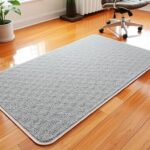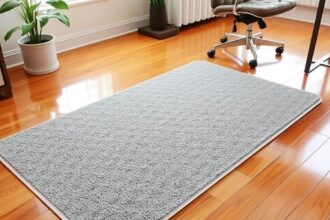Did you know food should be stored at least 6 inches off the floor in the food industry? This shows how important it is to store food right to avoid contamination and keep it safe.
The US FDA’s Food Code doesn’t say exactly how far, but 6 inches is a common rule. It acts as a barrier to stop food from getting contaminated. This space keeps your food safe from floor dirt, allergens, and pests.

Keeping food 6 inches off the floor is key to food safety and following rules. It helps stop bacteria spread, keeps pests away, and makes cleaning easier. This way, you can keep your storage areas clean and safe.
Read More: Protect Your Ride with Husky Car Mats
Recommended Distance for Storing Food from the Floor
Proper food storage means keeping food away from the floor. It’s best to store food at least 15 centimeters (6 inches) above the floor. This space helps prevent contamination and makes cleaning easier.
Storing food off the floor keeps it safe from dust, pests, and cleaning chemicals. This way, you can keep your food safe and of high quality.
Optimal Humidity and Temperature for Dry Storage
It’s also important to keep the right humidity and temperature in dry storage areas. The humidity should be between 50-55%, and the temperature between 10°C (50°F) and 21°C (70°F). These conditions help keep your food fresh longer.
Organizing and labeling food properly is key. Mark older items clearly and store them in front of newer ones. This helps with rotation and reduces waste. Shelves should be away from walls for good air flow, and food should stay in its original packaging for freshness.
Cleaning the storage area regularly is vital to avoid pests and ensure food safety. By following these tips, you can store food well, keep it fresh, and protect your customers’ health.

Why Food Should be Stored Away from the Floor
Keeping food safe is key. It’s important to store food at least 6 inches (15 cm) off the floor. This keeps food away from dirt and germs that can spread on the floor.
Floors Can Accumulate Contaminants
Kitchen and storage floors can pick up dust, pests, and cleaning chemicals. These can harm the food’s safety and quality. Dust and debris can carry bacteria, causing sickness. Pests like rodents and insects can also get to food stored on the floor.
Elevating Food Reduces Contamination Risks
Storing food off the ground lowers the chance of contamination. It stops bacteria and harmful substances from the floor getting to the food. It also makes it harder for pests to reach the food, as they have to climb up. This simple step is a big part of keeping food safe.
| Food Storage Guideline | Recommended Distance from Floor |
|---|---|
| Dry Goods | 6 inches (15 cm) |
| Refrigerated Foods | 6 inches (15 cm) |
| Frozen Foods | 6 inches (15 cm) |
| Fresh Produce | 6 inches (15 cm) |

By following these food storage guidelines and keeping food off the floor, you can stop food contamination. This helps keep your kitchen or food storage area clean and safe.
Alternative Methods for Storing Food Above the Floor
For food businesses with little storage space, there are smart ways to store food above the floor. These methods help keep food safe and prevent cross-contamination. They ensure proper food storage and follow food storage guidelines.
Elevate Foods with Shelving and Racks
Using storage drawers, shelves, tables, mobile carts, wire racks, or sanitized pallets can keep food off the ground. These solutions create a safe space from floor contaminants. They also make cleaning and hygienic food handling easier.
Contain Food in Designated Containers
Food can also be stored in special bins, boxes, or hooks to stay off the floor. These alternative food storage methods keep food away from contamination sources. Having specific areas for refrigerated or frozen foods also helps keep food at the right temperature.

By using these flexible storage solutions, food businesses can keep their food safe and elevated. This follows proper food storage rules and boosts food safety.
Importance of Proper Food Storage
Keeping food safe and preventing contamination is key for any food business. Storing food off the floor, as food safety rules suggest, is crucial. It helps lower the chance of bacteria spreading and keeps your products safe. This way, you protect public health and follow food storage rules from agencies like the FDA and USDA.
Maintaining Food Safety and Preventing Contamination
Floors can pick up dust, pests, and cleaning chemicals. Keeping food at least 6 inches off the floor acts as a barrier. It stops these contaminants from reaching your food. This simple step is vital for keeping food safe and handling it hygienically.
Complying with Food Regulations and Protecting Public Health
Following food storage regulations shows you care about food contamination prevention and public health protection. Proper storage keeps your products fresh and quality high. It also meets regulatory guidelines, building trust with customers and ensuring your business thrives.

Flooring Material Considerations for Food Storage Areas
The right flooring material is key for food safety and hygiene in storage areas. It must be easy to clean, resistant to moisture, durable, slip-resistant, and prevent pests. These features ensure food stays safe and meet all regulations.
Cleanability and Moisture Resistance
Materials like epoxy coating, stainless steel, or ceramic tiles are great for food storage. They’re smooth, non-absorbent, and easy to clean. This helps prevent food contamination. Also, floors should slope at least 2% to drain liquids and stop bacteria and pests.
Durability and Slip Resistance
The flooring must be tough to handle foot traffic, equipment, and cleaning chemicals. It should also be slip-resistant to keep employees safe and prevent accidents.
Pest Control Considerations
Floors without cracks or crevices are vital to prevent pests. Seamless floors with rounded edges and good drainage help keep pests away. They also make it easier to spot and fix any pest problems.
| Flooring Material | Cleanability | Moisture Resistance | Durability | Slip Resistance | Pest Control |
|---|---|---|---|---|---|
| Epoxy Coating | Excellent | Excellent | Excellent | Good | Good |
| Stainless Steel | Excellent | Excellent | Excellent | Good | Excellent |
| Ceramic Tiles | Excellent | Excellent | Good | Excellent | Good |
By thinking about these factors, food storage areas can be made safe and clean. They will also meet all the necessary standards and regulations.

food should be stored at least which distance from the floor
Keeping food safe means keeping it away from the floor. The food industry suggests storing food at least 6 inches off the ground. This space helps prevent contamination and makes cleaning easier.
The US Food and Drug Administration (FDA) doesn’t set a specific floor distance. But, the 6-inch rule is widely accepted for food safety. It keeps food away from dust, pests, and cleaning chemicals, which can harm its quality or safety.
| Recommended Food Storage Height | Reasoning |
|---|---|
| At least 6 inches above the floor | Prevents cross-contamination, facilitates cleaning, and reduces the risk of pest infestation |
To meet the 6-inch floor clearance, food businesses can use different storage solutions. For example:
- Storage drawers, shelving, and tables
- Mobile carts and wire racks
- Plastic pallets and storage bins
- Dedicated refrigerated or frozen storage areas
Following proper food storage practices is key to food safety. It helps meet regulations and protects public health. By doing so, food places can lower the chance of contamination and keep their products safe.
Conclusion Food Should be Stored
Keeping food off the floor is key to food safety. It helps prevent contamination and follows important guidelines. Using shelves and containers can also help keep food clean and safe.
It’s important to check with food safety experts often. This ensures your food storage meets current standards. By doing this, you show your customers you care about their health.
Following strict food storage rules is a smart move. It keeps your customers safe and supports a healthier food industry. By focusing on these practices, you help make food safer for everyone.
















